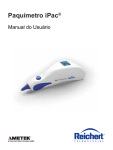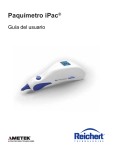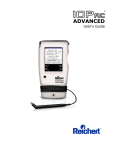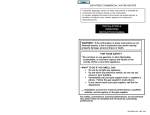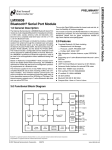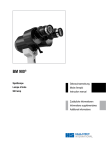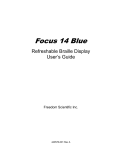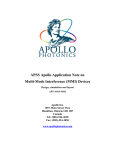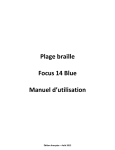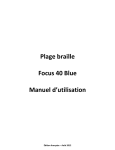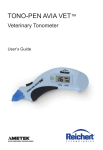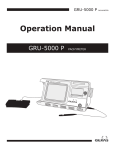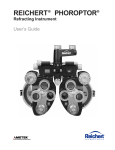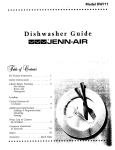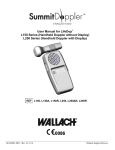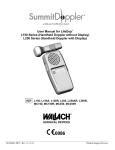Download iPac® Pachymeter
Transcript
iPac® Pachymeter User’s Guide ©2014 AMETEK, Inc. iPac, Reichert and Reichert Technologies are registered trademarks of Reichert, Inc. The Bluetooth word mark, figure mark, and combination mark are registered trademarks owned by Bluetooth SIG. AMETEK is a registered trademark of AMETEK, Inc. The information contained in this document was accurate at time of publication. Reichert, Inc. reserves the right to make changes in the product described in this manual without notice and without incorporating those changes in any products already sold. ISO 9001/13485 Certified – Reichert products are designed and manufactured under quality processes meeting ISO 9001/13485 requirements. No part of this publication may be reproduced, stored in a retrieval system, or transmitted in any form or by any means, electronic, mechanical, recording, or otherwise, without the prior written permission of Reichert, Inc. Caution: Federal law restricts this device to sale by or on the order of a licensed physician. Rx Only. Table of Contents Warnings and Cautions............................................................ 4 Symbol Information.................................................................. 7 Introduction............................................................................... 8 Instrument Setup......................................................................10 Unpacking Instructions.........................................................10 Parts Identification................................................................11 Accessories..........................................................................11 Optional Accessories............................................................11 Icon Description....................................................................12 Charging the iPac Pachymeter.............................................13 Power Up Mode....................................................................14 Measurement Mode.............................................................14 Sleep Mode..........................................................................14 iPac Setup Menu..................................................................15 iPac Menu Options ..............................................................17 Bluetooth...........................................................................17 About.................................................................................18 Date/Time..........................................................................19 Display...............................................................................20 Instrument Operation................................................................21 Measurement Screen...........................................................21 Operation..............................................................................23 Operational Check................................................................23 Patient Preparation...............................................................23 Measurement Process.........................................................24 Bluetooth Printing.................................................................26 iPac Bluetooth Printer...........................................................27 Cleaning and Disinfection........................................................28 iPac Cleaning Instructions....................................................28 Measurement Tip Cleaning Instructions...............................28 Maintenance and Storage........................................................29 General Maintenance...........................................................29 Battery..................................................................................29 Storage.................................................................................29 Troubleshooting........................................................................30 Specifications...........................................................................31 Disposal................................................................................31 Software Revision................................................................31 Guidance & Manufacturer’s Declaration...................................32 Regulatory Compliance - Bluetooth..........................................35 Acoustic Output........................................................................36 Warranty...................................................................................38 Appendix A...............................................................................39 16040-101 Rev. D 3 Warnings and Cautions WARNING: AN INSTRUCTION THAT DRAWS ATTENTION TO RISK OF INJURY OR DEATH. WARNING: UNITED STATES FEDERAL LAW AND EUROPEAN REGULATIONS REQUIRE THAT THIS DEVICE BE PURCHASED ONLY BY A PHYSICIAN OR A PERSON ACTING ON BEHALF OF A PHYSICIAN. ONLY USERS TRAINED IN THE USE OF OPHTHALMIC INSTRUMENTS THAT CONTACT THE EYE SHOULD USE THIS DEVICE. REICHERT TECHNOLOGIES CANNOT BE HELD RESPONSIBLE FOR ANY DAMAGE OR INJURY THAT RESULTS FROM A FAILURE TO FOLLOW DIRECTIONS IN THE USER’S MANUAL. PLEASE ENSURE THAT YOU ARE ENTIRELY FAMILIAR WITH THE CORRECT PROCEDURES FOR OPERATING THE INSTRUMENT BEFORE USE. WARNING: THIS INSTRUMENT SHOULD BE USED IN STRICT ACCORDANCE WITH THE INSTRUCTIONS OUTLINED IN THIS USER’S GUIDE. THE SAFETY OF THE OPERATOR AND THE PERFORMANCE OF THE INSTRUMENT CANNOT BE GUARANTEED IF USED IN A MANNER NOT SPECIFIED BY REICHERT TECHNOLOGIES. WARNING: DO NOT REPAIR OR SERVICE THIS INSTRUMENT WITHOUT AUTHORIZATION FROM THE MANUFACTURER. ANY REPAIR OR SERVICE TO THIS INSTRUMENT MUST BE PERFORMED BY EXPERIENCED PERSONNEL OR DEALERS WHO ARE TRAINED BY REICHERT OR SERIOUS INJURY TO THE OPERATOR OR PATIENT MAY OCCUR. WARNING: MODIFICATIONS TO THIS INSTRUMENT ARE NOT ALLOWED. ANY MODIFICATION TO THIS UNIT MUST BE AUTHORIZED BY REICHERT OR SERIOUS INJURY TO THE OPERATOR OR PATIENT MAY OCCUR. WARNING: ENSURE THAT THE VOLTAGE APPLIED TO THE UNIT IS THE SAME AS THE VOLTAGE THAT IS INDICATED ON THE DATA PLATE OR DAMAGE TO THE UNIT MAY OCCUR. WARNING: THIS INSTRUMENT IS NOT SUITABLE FOR USE IN THE PRESENCE OF FLAMMABLE ANESTHETIC MIXTURES, SUCH AS OXYGEN OR NITROUS OXIDE. WARNING: THE BATTERY SHOULD ONLY BE REPLACED WITH THE BATTERY SPECIFIED IN THIS MANUAL. USE OF ANOTHER BATTERY MAY CAUSE FIRE OR AN EXPLOSION. WARNING: AFTER EACH PATIENT, PERFORM THE CLEANING INSTRUCTIONS AS INDICATED IN THE CLEANING SECTION OF THIS MANUAL. WARNING: THE BATTERY SHOULD ONLY BE REPLACED WITH THE BATTERY SPECIFIED IN THIS MANUAL. USE OF ANOTHER BATTERY MAY CAUSE FIRE OR AN EXPLOSION. WARNING: DO NOT USE THE IPAC PACHYMETER IF THE MEASUREMENT TIP IS CRACKED, CHIPPED OR SHOWS ANY IRREGULARITY OF THE SURFACE, TO PREVENT PATIENT INJURY AND OR INACCURATE READINGS. WARNING: IF THIS INSTRUMENT IS MODIFIED, APPROPRIATE INSPECTION AND TESTING MUST BE CONDUCTED TO ENSURE CONTINUED SAFE USE OF THIS INSTRUMENT. WARNING: DO NOT EXPOSE THE BATTERIES TO TEMPERATURES ABOVE 140ºF, DISASSEMBLE THE BATTERIES, OR DAMAGE TO THIS UNIT AND/OR SERIOUS PERSONAL INJURY MAY RESULT. 4 16040-101 Rev. D Warnings and Cautions (continued) WARNING: DO NOT PLACE A SHORTING DEVICE BETWEEN THE BATTERY TERMINALS, OR ALLOW THE BATTERY TO BECOME WET. MISUSE OR IMPROPER DISPOSAL OF THIS BATTERY MAY CAUSE IT TO BECOME VERY HOT, IGNITE OR EXPLODE. DAMAGE TO THIS UNIT AND/OR SERIOUS PERSONAL INJURY MAY RESULT. WARNING: ALWAYS KEEP BATTERIES OUT OF THE REACH OF INFANTS AND YOUNG CHILDREN TO PREVENT THEM FROM BEING SWALLOWED. IF SWALLOWED, CONSULT A PHYSICIAN IMMEDIATELY. WARNING: NEVER ALLOW LIQUID LEAKING FROM THE BATTERY TO GET IN YOUR EYES OR MOUTH AS THIS LIQUID COULD CAUSE SERIOUS PERSONAL INJURY. IF IT COMES IN CONTACT WITH YOUR EYES OR MOUTH, FLUSH THEM IMMEDIATELY WITH PLENTY OF WATER AND CONSULT A PHYSICIAN. WARNING: IN ORDER TO PREVENT PATIENT-TO-PATIENT TRANSFER OF INFECTION, AFTER EACH USE DISINFECT THE MEASUREMENT TIP FOLLOWING ACCEPTED LOCAL CLINICAL PROCEDURES REGARDING THE USE OF DISINFECTANTS. ANY CLINICALLY APPROVED CHEMICAL DISINFECTANT CAN BE USED. WARNING: MEASUREMENTS SHOULD NOT BE ATTEMPTED WHEN OCULAR INTEGRITY IS QUESTIONABLE. THE HANDHELD TRANSDUCER MUST TOUCH THE EYE DURING OPERATION. CONSEQUENTLY, THE USER NEEDS TO EXHIBIT CARE IN MANIPULATING THE TRANSDUCER. FORCE SHOULD NOT BE EXERTED AGAINST THE EYE – THE TRANSDUCER TIP ONLY NEEDS TO LIGHTLY TOUCH THE CORNEA. WARNING: TO ENSURE PATIENT ISOLATION FROM HIGH ELECTRICAL POTENTIAL, DO NOT USE THE IPAC ON A PATIENT WHEN THE INSTRUMENT IS CHARGING. IPAC CHARGING MUST ONLY TAKE PLACE AT A DISTANCE OF AT LEAST 1.5 M FROM THE PATIENT. WARNING: IT IS PRUDENT TO MINIMIZE THE PATIENT’S EXPOSURE TO ULTRASOUND ENERGY TO A LEVEL AS LOW AS REASONABLY ACHIEVABLE (ALARA) BY REDUCING THE NUMBER OF SCANS NEEDED TO BE PERFORMED. ADVISE THE PATIENT OF WHAT TO EXPECT DURING A SCAN TO REDUCE REPETITIVE SCANS. THE AMERICAN INSTITUTE OF ULTRASOUND IN MEDICINE (AIUM) HAS A PUBLICATION “MEDICAL ULTRASOUND SAFETY” (1994) WHICH HAS MORE INFORMATION ON THIS TOPIC. CAUTION: AN INSTRUCTION THAT DRAWS ATTENTION TO THE RISK OF DAMAGE TO THE PRODUCT. CAUTION: DO NOT IMMERSE THE IPAC PACHYMETER IN FLUIDS OR DAMAGE TO THE ELECTRONICS MAY OCCUR. CAUTION: DO NOT ATTEMPT TO MODIFY THE IPAC PACHYMETER OR PATIENT INJURY, AND/OR INACCURATE READINGS MAY OCCUR. CAUTION: THIS DEVICE HAS NOT BEEN TESTED IN CONJUNCTION WITH HF SURGICAL (E.G. ELECTROCAUTERY) EQUIPMENT AND SHOULD NOT BE USED WITH SUCH EQUIPMENT. 16040-101 Rev. D 5 Warnings and Cautions (continued) CAUTION: THE INTERNAL CIRCUITRY OF THE INSTRUMENT CONTAINS ELECTROSTATIC DISCHARGE SENSITIVE DEVICES (ESDS) THAT MAY BE SENSITIVE TO STATIC CHARGES PRODUCED BY THE HUMAN BODY. DO NOT REMOVE THE COVERS WITHOUT TAKING PROPER ESDS PRECAUTIONS. CAUTION: THIS INSTRUMENT IS NOT INTENDED TO BE CONNECTED TO EQUIPMENT OUTSIDE THE CONTROL OF REICHERT INC. OR MUST BE TESTED TO AN APPLICABLE IEC OR ISO STANDARDS. CAUTION: DO NOT USE SOLVENTS OR STRONG CLEANING SOLUTIONS ON ANY PART OF THIS INSTRUMENT AS DAMAGE TO THE UNIT MAY OCCUR. SEE MAINTENANCE SECTION FOR DETAILED CLEANING INSTRUCTION. CAUTION: DO NOT AUTOCLAVE OR DISINFECT USING HIGH TEMPERATURES EXCEEDING THE RECOMMENDED TEMPERATURES INDICATED IN THE SPECIFICATIONS SECTION OF THIS MANUAL OR DAMAGE TO THE UNIT MAY OCCUR. CAUTION: DO NOT ATTEMPT INTERNAL STERILIZATION OF IPAC OR DAMAGE TO THE ELECTRONICS MAY OCCUR. CAUTION: USE OF AMMONIA BASED CLEANERS ON THE DISPLAY (OLED) MAY CAUSE DAMAGE TO THE DISPLAY. SEE MAINTENANCE SECTION FOR DETAILED CLEANING INSTRUCTION. CAUTION: MEDICAL ELECTRICAL EQUIPMENT NEEDS SPECIAL PRECAUTIONS REGARDING EMC AND NEEDS TO BE INSTALLED AND PUT INTO SERVICE ACCORDING TO THE EMC INFORMATION PROVIDED IN THIS GUIDE. PORTABLE AND MOBILE RF COMMUNICATIONS EQUIPMENT CAN AFFECT MEDICAL ELECTRICAL EQUIPMENT. CAUTION: ELECTROMAGNETIC INTERFERENCE FROM OTHER DEVICES MAY AFFECT THIS INSTRUMENT. IF INTERFERENCE IS PRESENT, TURN OFF OTHER ELECTRONIC DEVICES, OR REMOVE THEM FROM THE IMMEDIATE AREA WHILE OPERATING THIS INSTRUMENT. CAUTION: ALWAYS ENSURE THE IPAC IS CHARGED SUFFICIENTLY OR ERRATIC READINGS MAY OCCUR. USE ONLY THE SUPPLIED CHARGER PROVIDED WITH THE UNIT. IT IS RECOMMENDED THAT THE IPAC BE ATTACHED TO ITS CHARGER (OR CHARGING BASE) WHEN NOT IN USE TO ENSURE PROPER OPERATION. CAUTION: DO NOT ATTEMPT TO CHARGE THE IPAC OR POWER THE CHARGING CRADLE USING THE USB PORT OF A COMPUTER OR DAMAGE TO THE IPAC OR COMPUTER MAY OCCUR. 6 16040-101 Rev. D Symbol Information Indicates that important operating and maintenance instructions are included in this User’s Guide. Protective Earth - Indicates that a protective earth ground is connected where the symbol is located. REF SN 2014 Catalog Number Serial Number Date of Manufacture Waste of Electrical and Electronic Equipment Compliance to Medical Device Directive 93/42/EEC Consult Instructions for Use - Indicates that important operating and maintenance instructions are included in this User’s Guide. Authorized Representative in European Community Fragile Contents in Shipping Container - handle with care Keep Dry - Package shall be kept away from rain. Type BF Product Classification. Authorized to mark given by Intertek ETL Semko for conformance with electrical standards. C-Tick mark for ACMA in Australia Trade Marks Act 1995 and RSM in New Zealand under section 47 of the New Zealand Trademarks Acts. 16040-101 Rev. D 7 Introduction Congratulations on your purchase of the Reichert® iPac® Pachymeter. This User’s Guide is designed as a training and reference manual for operation, maintenance, and troubleshooting. We recommend that you read it carefully prior to use and follow the instructions in the guide to ensure optimum performance of your new instrument. If used properly, the iPac Pachymeter will provide you with fast, accurate and reliable measurements for many years. Properly trained eyecare professionals such as ophthalmologists, optometrists, opticians and eye care technicians should operate this instrument. Please retain this manual for future reference and to share with other users. Additional copies can be obtained from the Reichert Customer Service Department. Contact information is provided at the end of this guide. Intended Use The iPac Pachymeter is intended to measure thickness of the cornea in the human eye using ultrasound energy. Indications for Use The indications for use is to measure the thickness of the cornea. Contraindications None. Device Description The iPac Pachymeter is an ergonomic, hand-held Pachymeter that measures central corneal thickness. The body of the instrument is designed to fit comfortably in the user’s hand, facilitating fast and accurate measurements. The tip of the Pachymeter contains a sensor which measures central corneal thickness. The electronics housed in the ergonomic iPac Pachymeter body process and analyze the waveforms produced by each measurement of the corneal thickness of the eye. These are used to produce an averaged pachymetry measurement. The measurement is displayed on the Organic Light Emitting Diode (OLED) display. A rechargeable battery is used in the iPac Pachymeter and consists of a lithium ion battery. -continued8 16040-101 Rev. D Introduction (continued) Features The iPac Pachymeter has the following features: • Easy to Use - corneal thickness can be measured accurately by medical eye care professionals. • Portable - The iPac Pachymeter weighs just 3.53 oz. (100 g) and is rechargeable. • Versatile - The iPac Pachymeter may be used easily with the patient in any position, making the instrument suitable for the office, in clinics, at the hospital bedside, and in remote locations. • Bluetooth® Technology - wireless connectivity enabling communication to associated remote devices. • OLED Color Display - Intuitive graphical display for ease of use. Device Regulatory Classification • • • • Insulation Protection Class II Ingress ProtectionIPX0 Applied Part TypeBF Operation Mode Continuous 16040-101 Rev. D 9 Instrument Setup Unpacking Instructions Great care has been taken to deliver your iPac Pachymeter to you. The packaging was specifically designed to transport this instrument. Please retain the packaging for future use in case transportation is required. Removing the iPac Pachymeter 1. Lift the insert that contains the case and charger out of the box. Refer to Figure 1. 2. Unfold the insert and slide the case and charger out of the insert. 3. Open the carrying case, remove the User’s Guide and read the instructions carefully. 4. Remove the iPac from the case, and charge the instrument according to the Charging the iPac Pachymeter section. 5. Store the box and insert in a safe place so that if it is needed for future shipping, it will be available. The items listed below should be included in the iPac Pachymeter packaging: • Carrying Case • iPac Pachymeter • Lanyard • Tip Cover • User’s Guide • Battery (in the iPac) • A/C Adapter w/ Mini USB Shipping Box Carrying Case A/C Adapter Insert Shipping Box & Insert Note: If any of these items are missing, please contact the Reichert Customer Service Department. Contact information can be found on the back cover of this User’s Guide. 10 16040-101 Rev. D Instrument Setup (continued) Parts Identification 4 3 1 1. Pachymeter 2. Measurement Tip 3. Control button 4. OLED Display 2 iPac Pachymeter Accessories iPac Pachymeter User Guide (P/N 16040-101) Carrying Case (P/N 16040-380) Charging Cradle Lanyard (P/N 13851-096) Measurement Tip Cover (P/N 16040-027) iPac Rechargeable Lithium Ion Battery (P/N 16042) A/C Adapter w/ Mini USB (P/N 16040-430) Including Country Specific Pin Connector*: • North America (P/N 16040-410-001) • Australia (P/N 16040-410-002) • United Kingdom, Hong Kong, Singapore (P/N 16040-410-003) • European Union, South America (P/N 16040-410-004) • Korea (P/N 16040-410-005) • Argentina (P/N 16040-410-006) • China (P/N 16040-410-007) • India (P/N 16040-410-008) Optional Accessories iPac Pachymeter Charging Cradle (P/N 16041) iPac Bluetooth Printer (P/N 16043) * When ordering a replacement A/C Adapter, the corresponding Country Specific Pin must be orders as well. 16040-101 Rev. D 11 Instrument Setup (continued) Icon Description Move the Control button forward to go UP Move the Control button back to go DOWN Move the Control button back to go DOWN Move the Control button left to go LEFT Move the Control button right to go RIGHT Press and hold the Control button for the indicated time Press the Control button once and then release it Bluetooth ON, Bluetooth Connected Printer Connected Printer Not Connected Clear Battery Requires Charging Battery Low Power Battery Fully Charged Battery Charging 12 16040-101 Rev. D Instrument Setup (continued) Charging the iPac Pachymeter WARNING: CARE MUST BE TAKEN TO ARRANGE THE CABLES FOR THE ACCESSORIES SUCH THAT THEY DO NOT PRESENT A TRIPPING HAZARD TO THE EXAMINER OR A DANGER TO THE PATIENT. WARNING: POSITION THIS INSTRUMENT SO THAT IT IS NOT DIFFICULT TO OPERATE THE DISCONNECTION DEVICE (PLUG). CAUTION: USE ONLY THE SUPPLIED CHARGER PROVIDED WITH THE UNIT. IT IS RECOMMENDED THAT THE IPAC BE ATTACHED TO ITS CHARGER (OR CHARGING BASE) WHEN NOT IN USE TO ENSURE PROPER OPERATION. CAUTION: DO NOT ATTEMPT TO CHARGE THE IPAC OR POWER THE CHARGING CRADLE USING THE USB PORT OF A COMPUTER OR DAMAGE TO THE IPAC OR COMPUTER MAY OCCUR. The iPac can be charged directly with the A/C adaptor, or on the Charging Cradle. In either case, it is important to be sure that the Mini USB Plug is correctly oriented to the Mini USB Port, either on the iPac or the Charging Cradle. Without a Charging Cradle Note: The Mini USB Port and the Mini USB Plug have a flat side a curved side. The flat side of the Plug has a small rectangular cutout visible from the flat side. When connecting the Plug to the Port, be sure that the flat side of the Plug is lined up with the flat Port side of the Port. CAUTION: IF THE MINI USB PLUG IS NOT ALIGNED PROPERLY WITH THE MINI USB PORT, THE PORT MAY BREAK OFF AND THE PLUG MAY BECOME DAMAGED. Note: It is important to initially charge the iPac Pachymeter for the recommended period of time to ensure correct operation. 1. Plug the A/C Adaptor with Mini USB into an appropriately volted outlet. 2. Connect the Mini USB charging cord to the iPac Pachymeter. 3. Initially charge the unit for 10 hours. -continued16040-101 Rev. D Plug Correct Port Plug Incorrect Without Charging Cradle 13 Instrument Setup (continued) Charging the iPac Pachymeter (continued) With a Charging Cradle Note: The Mini USB Port and the Mini USB Plug have a flat side a curved side. The flat side of the Plug has a small rectangular cutout visible from the flat side. When connecting the Plug to the Port, be sure that the flat side of the Plug is lined up with the flat side of the Port. CAUTION: IF THE MINI USB PLUG IS NOT ALIGNED PROPERLY WITH THE MINI USB PORT, THE PORT MAY BREAK OFF AND THE PLUG MAY BECOME DAMAGED. Note: It is important to initially charge the iPac Pachymeter for the recommended period of time to ensure correct operation. Port 1. Plug the A/C Adaptor with Mini USB into an appropriately volted outlet. 2. Connect the Mini USB charging cord to the Charging Cradle. 3. Initially charge the unit for 10 hours. Plug Correct Port Power Up Mode Pressing the Control button initiates the iPac, the display will show “Press button to measure,” after about one minute of inactivity, the iPac will go into sleep mode, the display will turn off. To wake up the iPac press the control button and the display will light up. Plug Incorrect With Charging Cradle Measurement Mode In this mode the iPac has about 15 seconds to start the measurement process, if no measurements are taken then the display will show “Measurement Timeout” and then revert back to the “Press button to measure” display. Sleep Mode The iPac will automatically go into a power saving sleep mode after a period of inactivity, the display will turn off. Press the control button to exit the sleep mode and resume operation. There is no ON/OFF switch on this instrument. 14 16040-101 Rev. D Instrument Setup (continued) iPac Setup Menu The iPac setup menu enables the user to select the options that are preferred when using the pachymeter. Press and hold ( )the Control button for three seconds to display the Setup menu. At the top of the Display is a menu title (e.g., SETUP). If there is a small arrow on the left or right, moving the Control button LEFT or RIGHT will navigate through the menu screens in accordance with the arrows. Selecting the LEFT arrow displays the previous menu screen. Selecting the RIGHT arrow displays the highlighted selection. Selecting options in the menu screens is performed by moving the Control button UP, DOWN, LEFT, or RIGHT until the desired option is selected (highlighted). Press ( ) the Control button to activate the desired option. The iPac SETUP screens are the following: • Bluetooth • Date/Time • Display • About • Exit In the Setup menus there are options that will have specific colored indicator icons. The colors are: Green Icon - Indicates this option is turned On. Gray Icon - Indicates this option is turned Off. Yellow Icon - Indicates this option is in the process of turning On. 16040-101 Rev. D 15 Instrument Setup (continued) iPac Setup Menu (continued) Bluetooth The Bluetooth screen has three options: • Bluetooth - Press the control button to turn the Bluetooth option ON or OFF. • Search - Highlight the search option and press the control button to find any Bluetooth printer in the immediate area such as the iPac Bluetooth printer. The display will show the devices that have been discovered. (See printing section in this guide for connection instructions for the iPac Bluetooth printer.) • Detectable - This option allows the user to connect with a computer for electronic medical record data transfer. Date/Time The Date/Time menu is used to change the date and time format and also to set the current date and time, this will be printed with the measurement data. Display The display menu options are: • The eye can be set to either OD/OS or Right/Left (R/L). • IOP Correction can be set ON or OFF. • Standard Deviation can be set ON or OFF. • Locks the screen viewing orientation. • Sets the contrast on the display. • Sets the operating language. Note: Move the control button down to access the language option. About Displays the serial number and the software revision of the iPac. Exit Exits the Setup menu and returns to the Measure screen. 16 16040-101 Rev. D Instrument Setup (continued) iPac Menu Options Bluetooth Enable the following options by pressing ( ) the Control button. The status indicators on the iPac indicate the following: • Green - The Bluetooth function is ON. • Gray - The Bluetooth function is OFF. • Yellow - The iPac is enabling the Bluetooth function. Green Gray Note: If you are not using the Bluetooth feature, turn this option OFF. This will extend the battery life of the iPac. Search To perform a search for Bluetooth printing devices, perform the following: ) the Control button and the iPac searches the 1. Press ( local area for Bluetooth devices. 2. When the iPac is searching for a Bluetooth device the Bluetooth icon will blink. After the icon stops blinking, the iPac has completed its search and displays the available devices. 3. Highlight the Bluetooth device using the UP or DOWN icon and press ( ) the Control button. The Bluetooth icon will start blinking. After it stops blinking the iPac will display if the Bluetooth device is connected. Note: When the Bluetooth is connected a message is displayed “Bluetooth Connected.” If the connection was unsuccessful then a message is displayed indicating “Bluetooth Connection Failed.” 4. If the connection was unsuccessful, ensure that the printer has power to it and then repeat the Bluetooth connection process. Note: When a connection is made to a Bluetooth printer, the connection information is stored in the iPac. Whenever Bluetooth is turned on and no other connection has been made, the iPac will attempt to reconnect to the same printer. 16040-101 Rev. D 17 Instrument Setup (continued) iPac Menu Options (continued) Bluetooth (continued) Detectable The Detectable mode sets the iPac in a mode that allows communication with a Bluetooth compatible computer. When this mode is selected, the green color is set ON and the iPac is available to connect to a computer, however, the connection must be established by the computer to enable the transfer of data. The iPac’s Bluetooth passkey is shown at the bottom of the display when the Detectable mode is active The computer may request this passkey code when attempting to connect to the iPac. Note: The iPac can only have one active Bluetooth connection at a time. If a SEARCH is performed while DETECTABLE mode is active, the DETECTABLE mode will be turned OFF and any Bluetooth connection with the computer will be lost. If DETECTABLE is activated while the iPac has a Bluetooth connection to a printer, the printer connection will be lost. After the computer connection is established, the iPac can send data to the computer using the PRINT command. Please contact your EMR/EHR software provider, so that they can help configure your system to allow Bluetooth connectivity. About The About screen displays the following information: • Serial - displays the serial number of the unit. • Revision - Provides the revision of the operating software of the iPac. 18 16040-101 Rev. D Instrument Setup (continued) iPac Menu Options (continued) Date/Time The Date and Time format can be changed in Setup. • Date Format Sets the month, day and year format. • 12 or 24 Sets the option to display the hours in 12 hour or 24 hour format. • Set Allows the user to set the current date and time. To make changes to the Date/Time: 1. Highlight the option you want to change with the control button, move up ( ) and down ( ) the menu screen. 2. Press ( ) the control button and the display will change to show the available options. 3. Highlight the new option, moving up ( ) and down ( ) the menu. 4. To select the new option press ( ) the control button in and the option is selected and the display will return to the main Date/Time screen. 5. To make changes to the date and time value use the control button up ( ) and down ( ) function and then move to the next value by using the right ( ) or left ( ) function. Once all changes are made, press ( ) the control button in and the display will return to the main Date/Time menu. 16040-101 Rev. D 19 Instrument Setup (continued) iPac Menu Options (continued) Display The Display screen allows changes to the following options: • Eye: Displays the selected eye as OD/OS or R/L. OD = Right Eye. OS = Left Eye. • IOP Corr: IOP Correction value is displayed if the Option is set ON. The option is indicated by a green or gray icon next to the option (Gray is OFF, Green is ON). An IOP adjustment table is shown in Appendix A. • Std Dev: Displays the standard deviation for the CCT measurement. If this option is set OFF, then no standard deviation is displayed (Gray is OFF, Green is ON). • Lock: The display will change orientation as the instrument is rotated if this option is OFF. If the option is ON, the orientation of the display remains the same even if the instrument is rotated (Gray is OFF, Green is ON). • Contrast: Sets the contrast level of the display. Use the UP and DOWN Control button function to change the contrast of the screen. • Language: Sets the language of the instrument. Languages available are: English, German, French, Spanish, Portuguese, Italian. 20 16040-101 Rev. D Instrument Operation Measurement Screen In the measurement mode the display will have the following information displayed. OD/OS: This represents the patient’s eye. The highlighted option is the eye selected to be measured. The iPac always defaults to the right eye at the beginning of the measurement process. Move the control button right or left to select the eye you wish to measure. Bluetooth: The Bluetooth symbol will be displayed if this option has been turned on in the setup menu. If the icon is Gray then there is no connection to a printer or other device. The Bluetooth icon will be blue in color when a connection is made. Battery: The battery symbol indicates how much battery life is available. The battery symbol changes from green (full) to yellow to red (empty). When the battery symbol is red, it is time to re-charge the battery. OD/OS Bluetooth Battery Clear Clear: Move the control button UP and hold it until the display shows “Measurement cleared” All data will be cleared and a new measurement can be started. Readings: This number represents the CCT measurement for the selected eye. To review the measurement of the opposite eye, move the control button right or left. Reading Print IOP Offset Print: Measurements can be sent to the iPac Bluetooth printer or an EMR computer system. Move the control button down to send the measurement data. To clear the data after printing move the button up and all the measurement data will be cleared. IOP Offset: The number on the lower right is the IOP Offset number that is associated with the pachymetry reading. Refer to Appendix A for the IOP adjustment chart. Standard Deviation Std. Dev: The number in the lower left of the screen is the standard deviation of the CCT measurement. The standard deviation is how much variation or “dispersion” there is from the average measured value. Note: If the CCT measurement is displayed in orange then the standard deviation is greater than 10 (σ > 10). This is an indication that another set of measurements should be taken. 16040-101 Rev. D 21 Instrument Operation (continued) Measurement Screen (continued) Asterisks Asterisks When the instrument is ready to take measurements, three asterisks (***) are displayed on the screen. After five or more measurements are acquired the asterisks will change and display the average value. The number of measurements are displayed below the asterisks (e.g., 6/25). If it is difficult to get measurements from a patient, fewer than 25 measurements can be taken, the average will be based on the fewer measurements. Clearing Data To clear data on the display, move the Control button up ( ) for about 2 seconds, until the display indicates that the measurements have been cleared. 22 16040-101 Rev. D Instrument Operation (continued) Operation CAUTION: IT IS PRUDENT TO MINIMIZE THE PATIENT’S EXPOSURE TO ULTRASOUND ENERGY TO A LEVEL AS LOW AS REASONABLY ACHIEVABLE (ALARA) BY REDUCING THE NUMBER OF SCANS NEEDED TO BE PERFORMED. ADVISE THE PATIENT OF WHAT TO EXPECT DURING A SCAN TO REDUCE REPETITIVE SCANS. THE AMERICAN INSTITUTE OF ULTRASOUND IN MEDICINE (AIUM) HAS A PUBLICATION “MEDICAL ULTRASOUND SAFETY” (1994) WHICH HAS MORE INFORMATION ON THIS TOPIC. Operational Check Measure the patient according to the following procedure and precautions. WARNING: DO NOT USE THE IPAC PACHYMETER IF THE MEASUREMENT TIP IS CRACKED, CHIPPED OR SHOWS ANY IRREGULARITY OF THE SURFACE, TO PREVENT PATIENT INJURY, AND/OR INACCURATE READINGS. 1. Before using, visually inspect the Pachymeter’s sensor for cracks, chips or other irregularities. Do not use the pachymeter if the tip is cracked, chipped, or shows any kind of irregularity of its surface. 2. Press and release the control button ( ) to activate the iPac. Note: The instrument will automatically enter the power OFF sequence after inactivity of approximately one minute. 3. Check the battery icon to ensure that the battery is fully charged. If the iPac needs charging, plug in the charger until the icon indicates that it is fully charged, or place it in the iPac Charging Cradle. CAUTION: ALWAYS ENSURE THE IPAC IS CHARGED SUFFICIENTLY OR ERRATIC READINGS MAY OCCUR. Patient Preparation 1. Advise the patient of the measuring process and what to expect before taking measurements. 2. Have the patient sit comfortably and install a drop of topical anesthetic into the eye to be examined. 3. Give the patient the appropriate time for the anesthetic to start working. 16040-101 Rev. D 23 Instrument Operation (continued) Measurement Process 4. Instruct the patient to look straight ahead at a fixation target (e.g., ear, nose, distant object) to minimize eye movement, with eyes fully open to prepare for a measurement. 5. Hold the iPac Pachymeter as you would a pencil and to enable viewing of the sensor and the patient’s cornea where contact will be made. For normal corneas, central corneal contact is highly recommended. Note: The corneal surface needs only to be contacted for a short time. Indentation or additional pressure is not required and may lead to injury to the eye. 6. Support the iPac with your hand, and if necessary, stabilize the movement of the iPac by resting your hand against the patient. 7. Press and release the Control button, one time ( ). The iPac will initiate the measurement process and beep once. After the beep, three asterisks are displayed. 8. Minimizing the time the Pachymeter is touching the eye, lightly touch the center of the cornea until the iPac completes a series of beeps followed by a single beep. 9. After the series of beeps and the final beep, remove the iPac from the eye. The iPac will display the average reading. 24 16040-101 Rev. D Instrument Operation (continued) Measurement Process (continued) ) or left ( ) as 10.Move the Control button to the right ( needed to acquire measurements on the other eye and repeat the above process. 11.To review the measurement data, you can “toggle” between the right and left eye by moving the control button right ( ) or left ( ). 12.To send the measurement data to a Bluetooth printer or computer EMR system, move the Control button down ( ). The data will be sent to the connected device, if the data is not transferred refer to the Bluetooth setup section of this user’s guide. Note: If a Bluetooth device was found and the connection established in Setup, then move the Control button down ( ) to send the data to the Bluetooth device. 13.To clear the measurement data, move the control button up ( ) and hold it until the display shows “measurement cleared.” 14.Perform the cleaning instructions in the Cleaning and Disinfection section of this manual. Note: If you are unable to take 25 measurements, the average will be displayed for the number of measurements that were taken. Either press the control button down once or wait for about 15 seconds and the display will change to show the print and clear icon. 16040-101 Rev. D 25 Instrument Operation (continued) Bluetooth Printing Bluetooth is a wireless communication protocol for exchanging data over short distances. The iPac uses Bluetooth for printing and communicating with a computer EMR system. To setup these options please refer to the iPac Menu Options, Bluetooth section of this User’s guide. There are 3 Bluetooth modes which are visible from the measurement screen of the iPac. Bluetooth OFF The Bluetooth icon is not shown. Bluetooth ON The basic Bluetooth icon is shown. Bluetooth Connected The Bluetooth icon is blue with a highlight around the icon and indicates that it is connected to a device and ready to send data to the device. iPac Bluetooth Printer To connect to the iPac Bluetooth printer follow the instructions below: 1. Ensure the iPac Bluetooth option is turned on, see iPac Menu Options, Bluetooth. 2. Press the ON/OFF button on the iPac printer so that the printer is ON. A green LED will indicate the printer is working. 3. In the iPac Bluetooth setup mode select the search option, and press ( ) the control button, the Bluetooth icon will blink on and off while the iPac searches for the printer. 4. Once the search is complete the iPac display will usually show the iPac printer as MARTEL MCP7880. Highlight this option and press the control button in, the iPac will then connect to the printer. The display will show “Bluetooth connected.” Note: If the display shows “Bluetooth connection failed” ensure that the printer is turned on and then repeat the process described above. -continued26 16040-101 Rev. D Instrument Operation (continued) iPac Bluetooth Printer (continued) 5. Exit the iPac setup mode. 6. The iPac is now connected to the iPac printer, to send measurement data to the ), the data printer after measuring a patient, move the Control button down ( will be sent to the iPac printer and printed. A sample printout is shown below. Note: If the printer fails to print, check that the printer is turned on, green LED illuminated and ensure that the Bluetooth icon on the iPac display shows it is connected. Note: When a connection is made to a Bluetooth printer, the connection information is stored in the iPac. Whenever Bluetooth is turned on and no other connections have been made, the iPac will attempt to reconnect to the same printer. 16040-101 Rev. D 27 Cleaning and Disinfection iPac Cleaning Instructions Perform the following procedure when cleaning the outside of the iPac Pachymeter. CAUTION: DO NOT IMMERSE THE INSTRUMENT IN LIQUIDS OR AUTOCLAVE OR DAMAGE TO THE ELECTRONICS OF THE PACHYMETER WILL OCCUR. 1. After using the iPac Pachymeter, we recommend wiping the outside of the instrument with a soft, cotton cloth lightly moistened with 70% isopropyl alcohol. 2. After cleaning, wipe the outside of the instrument with a soft, cotton cloth lightly moistened with sterile distilled water. 3. Dry the unit with a lint free cloth or tissue. Note: Always store the pachymeter in its case when not being used for an extended period of time. Measurement Tip Cleaning Instructions Perform the following procedure when cleaning and disinfecting the iPac measurement tip. WARNING: DO NOT ATTEMPT TO USE THE IPAC IF THERE IS ANY INDICATION THE MEASUREMENT TIP HAS BEEN DAMAGED AND/OR THEIR PHYSICAL INTEGRITY HAS BEEN COMPROMISED. IF THE MEASUREMENT TIP HAS MADE CONTACT WITH ANYTHING BETWEEN APPLANATIONS, CLEAN THE TIP ACCORDING TO THE MEASUREMENT TIP CLEANING INSTRUCTIONS OR SERIOUS INJURY MAY OCCUR. 1. After each patient, we recommend wiping the measurement tip with a cotton swab soaked in 70% isopropyl alcohol. CAUTION: DO NOT IMMERSE THE INSTRUMENT IN LIQUIDS EXCEPT FOR ONLY THE MEASUREMENT TIP OF THE PACHYMETER OR DAMAGE TO THE ELECTRONICS OF THE PACHYMETER WILL OCCUR. 2. Immerse only the measurement tip for 10 minutes in 70% isopropyl alcohol or an equivalent locally approved disinfectant. 3. After cleaning, rinse the end of the measurement tip thoroughly with sterile distilled water. 4. Dry the measurement tip with a lint free cloth or tissue. Note: Always store the pachymeter in its case when not being used for an extended period of time. 28 16040-101 Rev. D Maintenance and Storage General Maintenance This instrument performs an internal check of the unit just before the unit indicates that it is ready to measure. If the unit displays that it is ready to measure, then the system check was successfully completed and the unit is ready for use. Battery Replace the iPac Battery when it stops holding a charge. Battery Replacement: 1. On the back of the iPac is the battery door. Open it by pushing the latch towards the door and lifting the door. 2. Disconnect the battery harness from the iPac. 3. Replace the battery and connect the battery harness to the iPac. Note: Be sure that the battery is oriented correctly so that the door can close properly. If the battery is oriented incorrectly, the harness may become damaged and the door may not close. If the battery harness becomes damaged, the battery will need to be replaced. The battery should connect at the harness, the wires should lay flat along the side of the battery compartment, and then attach to the battery at the bottom. If the wires are bunched up at the top, near the point of connection to the iPac, then the battery is oriented incorrectly. Battery Harness Correct 4. Attach the door and ensure that it latches closed. 5. Charge the battery for approximately 10 hours before using. Note: Refer to Disposal section of this manual for your local laws and ordinances regarding the proper disposal of the battery. Incorrect Battery Orientation Storage If the instrument is to be stored for an extended period or prepared for transportation, remove the iPac battery to avoid possible damage to the instrument due to battery leakage. 16040-101 Rev. D 29 Troubleshooting The table below provides a guide for troubleshooting some basic iPac Pachymeter operational problems. If a problem persists after using this guide contact Reichert for further assistance. SYMPTOM Will not turn on. Battery symbol low. Multiple inaccurate readings. No beeps when measuring. Battery will not charge. Error Code Displayed. 30 PROBABLE CAUSE CORRECTION Battery is drained. Attach the charger to the iPac and fully charge the battery. Battery is defective. Replace Battery. Low iPac battery capacity. Attach the charger to the iPac and charge it until the icon indicates full. Improper technique. Review “Measurement” Section of this manual. Debris on tip. Clean sensor tip. Mechanical or electronic damage. Arrange for service through Reichert Technical Service Group. Control button not properly pressed. Press Control button. Battery is drained. Attach the charger to the iPac and charge it until the icon indicates full. Mechanical or electronic damage. Arrange for service through Reichert Technical Service Group. Defective battery. Replace iPac battery pack Software anomaly. Remove and install the battery pack to reset hardware. Malfunction of the iPac. Contact the Reichert Technical Service Group for technical support and provide error message. 16040-101 Rev. D Specifications PHYSICAL DIMENSIONS Size Length: 7.05 in. (179 mm) Width: 1.46 in. (37.0 mm) Height: 2.20 in. (56.0 mm) Weight: 3.53 oz.(100 g) 5°C 10% 90% Relative Humidity range: 20 to 80% RH Atmospheric Pressure range: 70 to 106 kPa (20.7 to 31.6 in.Hg) Measurement Tip Diameter: .08 in. (2.0 mm) 45°C ENVIRONMENTAL REQUIREMENTS Operational Environment Ambient Temperature range: 50°F to 95°F (10 °C to 35°C) 106 kPa 50 kPa RANGE OF MEASUREMENTS 200 to 1000 µm, ±5 µm Transport and Storage Environment Ambient Temperature range: 41°F to 113°F (5 °C to 45°C) Relative Humidity range: 10 to 90% RH (non-condensing) Atmospheric Pressure range: 50 to 106 kPa (14.8 to 31.6 in.Hg) ELECTRICAL Measurement tip Ultrasound Frequency: 10.5 MHz Straight Probe Battery Pack Voltage: 3.7V LI-ION Battery Pack A/C Adaptor Input Voltage: 100-240 Vac, 50-60 Hz, 0.16 A max A/C Adaptor Output: 5Vdc, 1.2A max Disposal This product does not generate any environmentally hazardous residues. At the end of its product life, follow your local laws and ordinances regarding the proper disposal of this equipment. Software Revision The software revision can be obtained by contacting Reichert, Inc. The serial number identifies the manufacture date and will provide access to the software version. 16040-101 Rev. D 31 Guidance & Manufacturer’s Declaration Table 201 – Guidance and Manufacturer’s Declaration Electromagnetic Emissions All Equipment and Systems Guidance and Manufacturer’s Declaration – Electromagnetic Emissions The iPac is intended for use in the electromagnetic environment specified below. The customer or user of the iPac should ensure that it is used in such an environment. Emissions Test Compliance RF Emissions CISPR 11 Group 1 Class B Harmonics IEC 61000-3-2 Class A Flicker IEC 61000-3-3 Complies Electromagnetic Environment - Guidance - The iPac uses RF energy only for its internal function. Therefore, its RF emissions are very low and are not likely to cause any interference in nearby electronic equipment. The iPac is suitable for use in all establishments, other than domestic establishments and those directly connected to the public low-voltage power supply network that supplies building used for domestic power. Table 206 – Recommended Separation Distances between Portable and Mobile RF Communications Equipment and the iPac for ME Equipment and ME Systems that are NOT Life-supporting. Guidance and Manufacturer’s Declaration - Electromagnetic Immunity Recommended Separation Distances for between Portable and Mobile RF Communications Equipment and the iPac The iPac is intended for use in the electromagnetic environment in which radiated RF disturbances are controlled. The customer or user of the iPac can help prevent electromagnetic interference by maintaining a minimum distance between portable and mobile RF Communications Equipment and the iPac as recommended below, according to the maximum output power of the communications equipment. Separation (m) Max Output Power 150kHz to 80 MHz of Transmitter (W) d=(3.5/V1)(Sqrt P) Separation (m) 80 to 800 MHz Separation (m) 800MHz to 2.5GHz d=(3.5/E1)(Sqrt P) d=(7/E1)(Sqrt P) 0.01 0.1166 0.1166 0.2333 0.1 0.3689 0.3689 0.7378 2.3333 1 1.1666 1.1666 10 3.6893 3.6893 7.3786 100 11.6666 11.6666 23.3333 For transmitters rated at a maximum output power not listed above, the recommended separation distance (d) in meters (m) can be estimated using the equation applicable to the frequency of the transmitter, where P is the maximum output power rating of the transmitter in watts (w) according to the transmitter manufacturer. Note 1: At 80 MHz and 800 MHz, the separation distance for the higher frequency range applies. Note 2: These guidelines may not apply in all situations. Electromagnetic propagation is affected by absorption and reflection from structures, objects, and people. 32 16040-101 Rev. D Guidance & Manufacturer’s Declaration (continued) Table 202 – Guidance and Manufacturer’s Declaration Electromagnetic Immunity All Equipment and Systems Guidance and Manufacturer’s Declaration – Electromagnetic Immunity The iPac is suitable for use in electromagnetic environment specified below. The customer or user of the iPac should ensure that it is used in such an environment. Immunity Test IEC 60601 Test Level Compliance Level Electromagnetic Environment - Guidance ESD IEC 61000-4-2 ±6kV Contact ±8kV Air ±6kV Contact ±8kV Air Floors should be wood, concrete or ceramic tile. If floors are synthetic, the R/H should be at least 30%. EFT IEC 61000-4-4 ±2kV Mains ±1kV I/Os ±2kV Mains ±1kV I/Os Mains power quality should be that of a typical residential, commercial or hospital environment. Surge IEC 61000-4-5 ±1kV Differential ±2kV Common ±1kV Differential ±2kV Common Mains power quality should be that of a typical residential, commercial or hospital environment. >95% Dip for 0.5 Cycle >95% Dip for 0.5 Cycle 60% Dip for 5 Cycles 60% Dip for 5 Cycles Mains power quality should be that of a typical residential, commercial or hospital 30% Dip for 25 Cycles 30% Dip for 25 Cycles >95% Dip for 5 Seconds >95% Dip for 5 Seconds 3A/m 3A/m Voltage Dips/Dropout IEC 61000-4-11 Power Frequency 50/60Hz Magnetic Field IEC 61000-4-8 16040-101 Rev. D environment. If the user of the iPac requires continued operation during power mains interruptions, it is recommended that the iPac be powered from an uninterruptible power supply or battery. Power frequency magnetic fields should be that of a typical residential, commercial or hospital environment. 33 Guidance & Manufacturer’s Declaration (continued) Table 204 – Guidance and Manufacturer’s Declaration Electromagnetic Immunity Equipment and Systems that are NOT Life-supporting Guidance and Manufacturer’s Declaration – Electromagnetic Immunity The iPac is intended for use in the electromagnetic environment specified below. The customer or user of the iPac should ensure that it is used in such an environment. Immunity Test Conducted RF IEC 61000-4-6 Radiated RF IEC 61000-4-3 IEC 60601 Test Level Compliance Level 3 Vrms 150 kHz to 80 MHz (V1) = 3 Vrms 80 MHz to 2.5 GHz @ 3V/m (E1) = 3 V/m Electromagnetic Environment - Guidance Portable and mobile RF communications equipment should be no closer to any part of the iPac, including cables, than the recommended separation distance calculated from the equation applicable to the frequency of the transmitter. Recommended Separation Distance: d=(3.5/V1)(Sqrt P) d=(3.5/E1)(Sqrt P) 80 to 800 MHz d=(7/E1)(Sqrt P) 800 MHz to 2.5 GHz Where P is the max output power rating of the transmitter in watts (W) according to the transmitter manufacturer and d is the recommended separation distance in meters (m). Field strengths from fixed transmitters, as determined by an electromagnetic site survey, should be less than the compliance levels in each frequency range. Interference may occur in the vicinity of equipment marked with the following symbol. Note 1: At 80 MHz and 800 MHz, the higher frequency range applies. Note 2: These guidelines may not apply in all situations. Electromagnetic propagation is affected by absorption and reflection from structures, objects and people. * Field strengths from fixed transmitters, such as base stations for radio (cellular/cordless) telephones and land mobile radios, amateur radio, AM and FM radio broadcast and TV broadcast cannot be predicted theoretically with accuracy. To assess the electromagnetic environment due to fixed RF transmitters, an electromagnetic site survey should be considered. The measured field strength in the location in which the ME Equipment or ME System should be observed to verify normal operation. If abnormal performance is observed, additional measures many be necessary, such as re-orienting or relocating the ME Equipment or ME System. * Over the frequency range 150 kHz to 80 MHz, field strengths should be less then [V1] V/m. 34 16040-101 Rev. D Regulatory Compliance - Bluetooth The LMX9838 has been tested and approved to be compliant to the following regulatory standards: CE Compliance: • EN 300 328 v1.7.1 • EN 301 489-17 v1.2.1 IC Compliance: • RSS-GEN Issue 1 • RSS-210 Issue 7 Annex 8 and RSS-GEN issue 2 FCC Compliance: • FCC Part 15 Subpart C 20.1 FCC INSTRUCTIONS 20.1.1 Safety Information For Rf Exposure 20.1.1.1 FCC Radiation Exposure Statement: This module may only be installed by the OEM or an OEM integrator. The antenna used for this transmitter must not be co-located or operating in conjunction with any other antenna or transmitter. OEM integrators and End-users and installers must be provided with antenna installation instructions and transmitter operating conditions for satisfying RF exposure compliance. Only the antenna filed under FCC ID: ED9LMX9838 can be used with this device. 20.1.1.2 End Product Labeling FCC ID label on the final system must be labeled with “Contains TX FCC ID: ED9LMX9838 “or “Contains transmitter module FCC ID: ED9LMX9838”. IC label on the final system must be labeled with “Contains TX IC: 1520A-LMX9838” or “Contains transmitter module IC: 1520A-LMX9838”. 20.1.1.3 End Product Manual Information In the user manual, final system integrator must ensure that there is no instruction provided in the user manual to install or remove the transmitter module. LMX9838SB must be installed and used in strict accordance with the manufacturer’s instructions as described in the user documentation that comes with the product. The following information is required to be incorporated in the user manual of final system. 16040-101 Rev. D USA-Federal Communications Commission (FCC) This equipment has been tested and found to comply with the limits for a Class B digital device, pursuant to Part 15 of FCC Rules. These limits are designed to provide reasonable protection against harmful interference in a residential installation. This equipment generates, uses, and can radiate radio frequency energy. If not installed and used in accordance with the instructions, it may cause harmful interference to radio communications. However, there is no guarantee that interference will not occur in a particular installation. If this equipment does cause harmful interference to radio or television reception, which can be determined by tuning the equipment off and on, the user is encouraged to try and correct the interference by one or more of the following measures: • Reorient or relocate the receiving antenna. • Increase the distance between the equipment and the receiver. • Connect the equipment to outlet on a circuit different from that to which the receiver is connected. • Consult the dealer or an experienced radio/TV technician for help. Any changes or modifications not expressly approved by the party responsible for compliance could void the user’s authority to operate the equipment. Caution: Exposure to Radio Frequency Radiation. This device must not be co-located or operating in conjunction with any other antenna or transmitter. Canada – Industry Canada (IC) This device complies with RSS 210 of Industry Canada. Operation is subject to the following two conditions: (1) this device may not cause interference, and (2) this device must accept any interference, including interference that may cause undesired operation of this device.” L ‘ utilisation de ce dispositif est autorisée seulement aux conditions suivantes : (1) il ne doit pas produire d’interference et (2) l’ utilisateur du dispositif doit étre pr?t ? accepter toute interference radioélectrique reçu,m?me si celle-ci est susceptible de compromettre le fonctionnement du dispositif. Caution: Exposure to Radio Frequency Radiation. The installer of this radio equipment must ensure that the antenna is located or pointed such that it does not emit RF field in excess of Health Canada limits for the general population; consult Safety Code 6, obtainable from Health Canada’s website www.hc-sc.gc.ca/rpb. 35 Acoustic Output Acoustic Output MI ISPTA.3 2 (mW/cm ) ISPPA.3 (W/cm2) Global Maximum Value 0.155±0.014 3.72±0.98 12.2±2.0 Pr.3 (MPa) 0.70±0.07 0.040±0.010 0.040±0.010 fc (MHz) 20.2±1.4 20.2±1.4 20.2±1.4 zsp (cm) 0.3 0.3 0.3 0.11 0.11 0.11 0.11 W c (mW) Associated Acoustic Parameters Beam Dimensions (cm) x-6 y-6 PD (ms) 0.07 0.07 PRF (Hz) 4600 4600 EBD (cm) Az El Operator Controls 0.2 0.2 There are no operator controls that alter the acoustic output power Uncertainties in the above values are reported as ±1 standard deviation. The derated intensities were derived from those measured in water based on the measured center frequency of the acoustic signal (fc, MHz) and the distance from the transducer to the point at which the intensity was measured (d, cm) using the formula: Derated Intensity = Measured Intensity *e-0.069*fc*d. In compliance with IEC61157 the peak rarefaction acoustic pressure (pr) is less than 1 MPa; the output beam intensity (Iob) is less than 20 mW/cm2; and the spatial-peak temporal average derived intensity (Ispta) is less than 100 mW/cm2. Definitions ISPTA.3 - derated spatial-peak temporal-average intensity (milliwatts per square centimeter). ISPPA.3 - derated spatial-peak pulse-average intensity (watts per square centimeter). MI - Mechanical Index. pr.3 - derated peak rarefactional pressure (megapascals) associated with the transmit pattern giving rise to the value reported under MI. Wo - ultrasonic power (milliwatts). For the operating condition giving rise to ISPTA.3, Wo is the total time-average power. For the operating condition giving rise to ISPPA.3, Wo is the ultrasonic power associated with the transmit pattern giving rise to the ISPPA.3 value. fc - center frequency (MHz). For MI and ISPPA.3, fc is the center frequency associated with the transmit pattern giving rise to the global maximum value of the respective parameter. zsp - axial distance at which the reported parameter is measured (centimeters). x-6, y-6 - are respectively the in-plane (azimuthal) and out-of-plane (elevational) -6 dB dimensions in the x-y plane where zsp is found (centimeters). 36 16040-101 Rev. D Acoustic Output (continued) Definitions (Continued) PD - pulse duration (microseconds) PRF - pulse repetition frequency (Hz) EBD - entrance beam dimensions for the azimuthal and elevational planes (centimeters). Tissue Exposure To Ultrasound Energy The ultrasound energy emitted by the iPac is of low intensity and will have no adverse effects on the patient and/or user. However, the user is still cautioned to perform examinations using the principle of ALARA (As Low As Reasonably Achievable). All examinations should be done so that the patient receives as little ultrasound radiation as possible. Do not hold the measurement tip against the eye or other tissue with the system activated except when making a measurement. Do not make unnecessary measurements. Ultrasonic Intensities The iPac has only one mode, and ultrasonic intensity settings are not under the control of the user. Thus, the values below are the values to be expected for a typical transducer. In Water In the Eye I SPTA, mw/cm2 5.14 5.13 I SPPA, W/cm2 10.23 10.22 MI(unitless) 0.171 0.170 Since the iPac is a contact instrument, the energy will always be attenuated by the tissue when used as recommended. However, since the focal length (point of maximum intensity) is very short (1 mm), and thus penetration into the eye is limited, the water values are effectively the same as the tissue values, for all practical purposes. If more accuracy is desired, the intensity in the eye at the transducer focus (corresponding to maximum intensity) may be calculated according to the formula recommended by the FDA: It=Iw x e(-0.069 x f x z) where It is the estimated in situ intensity, Iw is the measured intensity in water at the focus of the transducer, f is the ultrasonic frequency, and z is the distance from the face of the measurement tip to the transducer focus, which is the point of measurement (1mm). The nominal frequency of these transducers is 20 MHz. The actual frequency of a particular transducer may vary from this value. The tissue calculations above were done with the measured frequency of the transducer used for the tests. 16040-101 Rev. D 37 Warranty This product is warranted by Reichert, Inc. against defective material and workmanship under normal use for a period of three years from the date of invoice to the original purchaser. (An authorized dealer shall not be considered an original purchaser). Under this warranty, Reichert’s sole obligation is to repair or replace the defective part or product at Reichert’s discretion. This warranty applies to new products and does not apply to a product that has been tampered with, altered in any way, misused, damaged by accident or negligence, or which has had the serial number removed, altered or effaced. Nor shall this warranty be extended to a product installed or operated in a manner not in accordance with the applicable Reichert instruction manual, nor to a product which has been sold, serviced, installed or repaired other than by a Reichert factory, Technical Service Center, or authorized Reichert Dealer. Lamps, bulbs, charts, cards and other expendable items are not covered by this warranty. All claims under this warranty must be in writing and directed to the Reichert factory, Technical Service Center, or authorized instrument dealer making the original sale and must be accompanied by a copy of the purchaser’s invoice. This warranty is in lieu of all other warranties implied or expressed. All implied warranties of merchantability or fitness for a particular use are hereby disclaimed. No representative or other person is authorized to make any other obligations for Reichert. Reichert shall not be liable for any special, incidental, or consequent damages for any negligence, breach of warranty, strict liability or any other damages resulting from or relating to design, manufacture, sale, use or handling of the product. PATENT WARRANTY If notified promptly in writing of any action brought against the purchaser based on a claim that the instrument infringes a U.S. Patent, Reichert will defend such action at its expense and will pay costs and damages awarded in any such action, provided that Reichert shall have sole control of the defense of any such action with information and assistance (at Reichert’s expense) for such defense, and of all negotiation for the settlement and compromise thereof. PRODUCT CHANGES Reichert reserves the right to make changes in design or to make additions to or improvements in its products without obligation to add such to products previously manufactured. 38 16040-101 Rev. D Appendix A The IOP correction value is based on data of Ehlers et al (1975), modified from Stodmeister (1998). Mean of corneal thickness in healthy subjects; 545µm (Doughty and Zaman 2000) See adjustment chart indicated below for more information. 16040-101 Rev. D 39 Reichert Technologies 3362 Walden Ave Depew, NY 14043 USA Toll Free: 888-849-8955 Phone: 716-686-4500 Email: [email protected] www.reichert.com AMETEK GmbH Business Unit Reichert Carl-von-Linde-Strasse 42 85716 Unterschleissheim / Munich GERMANY Tel: +49 (89) 315 8911 0 Fax: +49 (89) 315 891 99 Email: [email protected] ISO-9001/13485 Registered September 5, 2014 16040-101 Rev D









































